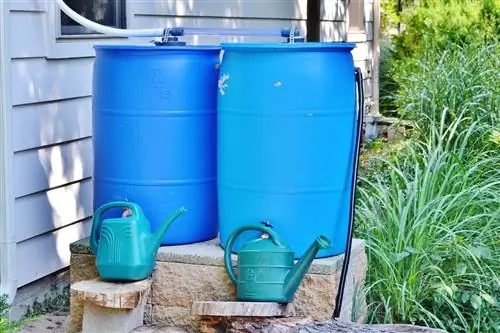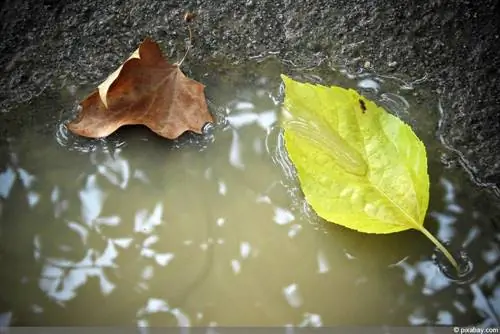- Author admin [email protected].
- Public 2023-12-17 03:39.
- Last modified 2025-10-04 22:41.
Collecting rainwater saves money and water resources and offers an ideal, low-lime irrigation option in the garden. There are various options for collecting rainwater with different advantages and disadvantages.
Classic plastic rain barrel
The best-known and easiest method for catching and collecting rainwater is the classic rain barrel. It is simply placed under gutters or downpipes and provided with a lid so that the rainwater does not get dirty.
Costs: depending on the filling capacity between 20 and 180 euros
Collection quantity: between 30 and 500 liters
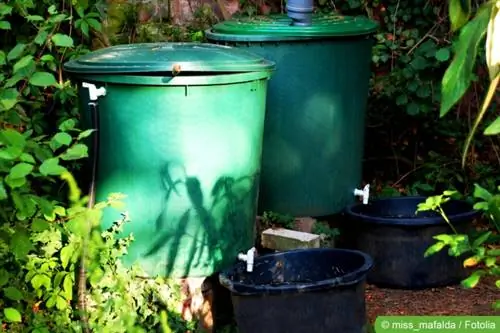
Advantages:
- can be ideally adjusted in size to suit the space available
- quick and easy to set up
- mobile and convertible
- can be equipped with tap and pump
- Above-ground installation and therefore always keep an eye on the water level
- Overflow protection available via overflow valve
Disadvantages:
- visually not an eye-catcher
- should be cleaned two to three times a year to avoid cyanobacteria
- Winter only three quarters full
- are exposed to the elements, which shortens the lifespan of plastic rain barrels
- popular breeding ground for mosquitoes
- should not be used on roofs with copper, zinc or tar paper due to possible metal compounds and/or biocides
- not suitable for domestic water supply
Wooden barrels
Wooden barrels are a more decorative alternative to the classic plastic rain barrel, especially for collecting rainwater. They meet similar requirements, but can be tastefully integrated into gardens due to their natural wood look.
Costs: between 160 and 450 euros
Collection quantity: between 180 and 500 liters
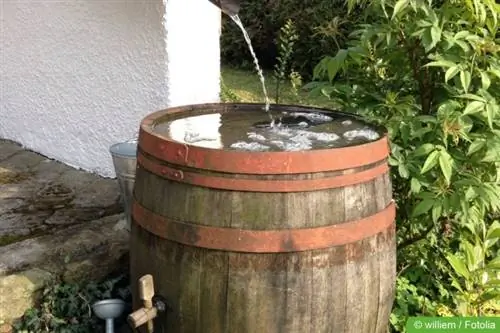
Advantages:
- underlines natural flair in the garden
- more robust and durable than plastic rain barrels (7 to 10 years average lifespan)
- quick and easy to set up
- mobile use
- can be equipped with tap and pump
- Above-ground installation and therefore always keep an eye on the water level
- Overflow protection available via overflow valve
Disadvantages:
- more expensive to purchase than plastic rain barrels
- Winter only three quarters full
- Wood requires regular care due to weather influences
- popular breeding ground for mosquitoes
- should not be used on roofs with copper, zinc or tar paper due to possible metal compounds and/or biocides
- not suitable for domestic water supply
Wall tank
The wall tank offers the most space-saving option for catching and collecting rainwater. It is mounted on a wall or facade near the gutter/downpipe and is characterized by its narrow depth and stylish design with a wood or stone look.
Costs: depending on size between 100 and 1,000 euros
Collection capacity: between 250 and 1,400 liters
Advantages:
- not recognizable as a rainwater collection container
- can be set up to save space
- provided with water drain valve or tap
- Garden hose connectable
- decorative lid
- can also be used as a shelf
- different designs and shapes available
- Mostly made of high-quality, high-density polyethylene, therefore very light and weather-resistant
- easy to change
Disadvantages:
- more expensive than simple plastic rain barrels with the same capacity
- must be cleaned two to three times a year to avoid cyanobacteria
- Winter only three quarters full
- should not be used on roofs with copper, zinc or tar paper due to possible metal compounds and/or biocides
- conditionally suitable for domestic water supply
Rain columns
This type of rainwater collection and collecting container is still quite new on the market and is a further development of the conventional rain barrel. Also called a column tank, it differs from this, among other things, in its smaller size.
Costs: depending on the size and filling capacity between 160 and 800 euros
Collection capacity: between 300 and 2,000 liters
Advantages:
- requires a smaller footprint with the same or larger filling volume
- More filling capacity than conventional rain barrels
- can be set up visually inconspicuously
- quick, easy assembly
- significantly cheaper than cisterns
- Natural water pressure thanks to column shape, making pump unnecessary
Disadvantages:
- Visually reminiscent of simple gas tanks without any attractive decorative value
- Water drain usually not included
- significantly more expensive than conventional rain barrels
Rainwater amphoras
A real highlight is to place rainwater amphoras in the garden as well as on terraces and balconies. They look like large, old Roman, pot-bellied vases and exude a Mediterranean charm because they are made of clay/terracotta.
Costs: between 90 and 600 euros
Collection capacity: 240 to 600 liters
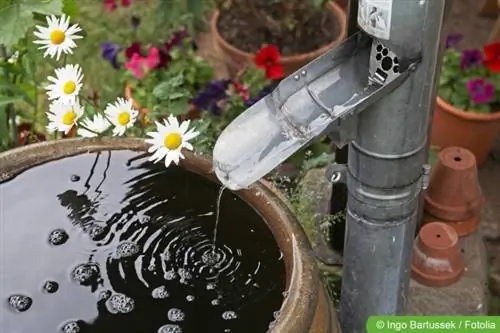
Advantages:
- particularly UV-stable and weather-resistant
- inconspicuous rainwater collection
- high decorative value thanks to stylish, Mediterranean design
- Planting possible
- Lower space requirement due to smaller floor space than with conventional rain barrels and wooden barrels
- with water drain
- mostly garden hose connectable
- Terracotta as an environmentally friendly and sustainable raw material
- natural water filtration and consequently reduction of chemicals for water disinfection
- Water level measurement possible
- frostproof
Disadvantages:
- regular cleaning required
- Cleaning more difficult due to shape
- smaller capacity than other rainwater containers
Tip:
If you don't like the look of rainwater amphorae, you will find a comparable option for collecting rainwater in the 2-in-1 design barrels. These are constructed similarly to normal plant pots and, like amphorae, consist of a combination of “rain barrel” and plant pot.
Rainwater Cisterns
For the almost invisible and larger collection of rainwater, a cistern that is inserted into the ground is ideal. The rainwater is channeled into the cistern via larger roof areas and can be used in a variety of ways.
Costs: depending on size and condition between 1,000 and 6,000 euros plus installation, connection and water pump
Collection quantity: up to 100,000 liters
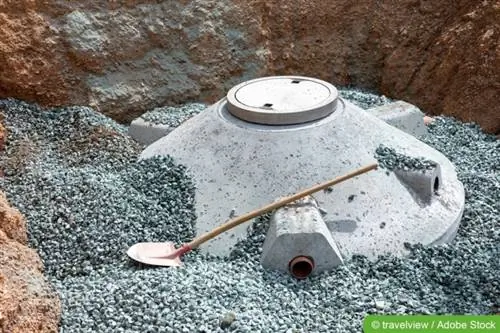
Advantages:
- with domestic waterworks can also be used for toilets, washing machines, dishwashers and bathing
- Connection of lawn sprinklers, garden hoses and other irrigation systems possible
- Connection to tap for normal water extraction
- Size adjustment to personal needs for a large family (as long as there is enough rain)
- high savings on water costs
- no building permit for loose plastic cistern
Disadvantages:
- depending on size and structural scope, higher investment costs than for rain barrels
- Investments sometimes only pay off after years
- Cost savings depending on amount of rain
- If the amount of precipitation is too low, switching to urban fresh water supply is necessary
- only suitable for garden owners
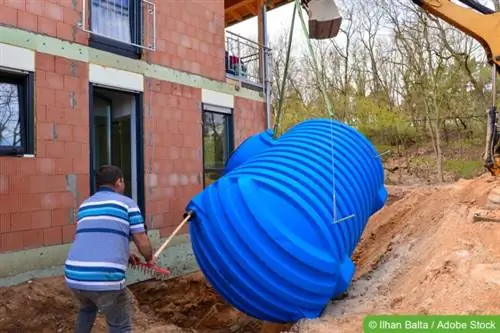
Tip:
Cisterns can be installed throughout Germany without a permit, but in most federal states there is a maximum size of 50 cubic meters. If the size is exceeded, approval must be obtained.
Infiltration systems
The infiltration systems are particularly suitable in regions with high rainfall. They consist of special shafts and/or drainage pipes into which the rainwater is absorbed underground in order to slowly release it into the earth, thus providing an automatic irrigation system.
Costs: between 5 and 45 euros per square meter, if applicable, plus costs for floor work; Professional trench infiltration up to 5,000 euros total costs
Collection capacity: depending on rainfall, soil density and system size
Advantages:
- Savings on wastewater fees
- Targeted soil irrigation without having to do anything yourself
- hardly or no more watering or blasting required
Disadvantages:
- complex, time-consuming assembly with floor work
- only recommended for new buildings and redesigns of gardens
- no other use possible
- Risk of blockages in drainage pipes
Frequently asked questions
What should you consider when considering the weight of rain collection containers on a balcony?
Balconies are only designed for a certain load weight. Structural engineers assume 300 kilograms per square meter for a standard balcony. If this applies to your balcony, a rainwater collection container may only have a capacity of less than 300 liters, although the weight should not be forgotten. In addition, your own body weight must also be deducted from the filling capacity when you enter the square meter of stand area to draw water.
Can I also use a free-standing, open rain barrel without a downpipe connection?
Theoretically yes, in practice you should avoid it. Open rain barrels pose a major drowning risk for various animals, such as squirrels, cats and ecologically valuable insects. Therefore, rainwater collection containers should always be closed. Furthermore, 5 liters of precipitation per square meter corresponds to heavy rain and a water level of 0.5 milliliters. It therefore takes ages until a rain barrel is fairly full.
Do underground plastic rain containers last longer than above-ground ones?
Plastic rain containers in the ground are protected from direct weather influences such as sun, rain, heat and frost, provided they are buried deep enough. However, there are also differences in quality that are relevant to durability and that should be taken into account. For example, thicker and denser plastic walls are more robust and less susceptible to age-related damage. Therefore, you should avoid buying inferior, particularly cheap offers.
How do I know how big my rainwater collection container should be?
The optimal size of a rainwater collection container depends on the roof area, its material as well as the rainfall in the respective region and the water requirement. But a rule of thumb for water requirements is: 10 liters per square meter per week for flower beds and 20 liters per square meter per week for lawns. However, these are only guidelines and serve as orientation only.

